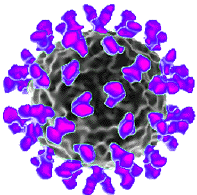| x | x | |||||
 |
||||||
| Contact us | Today is | |||||
|
IMMUNOLOGY
|
Viruses come in two basic types, those that have a genome of DNA and those that have a genome of RNA. THE CHAPTER NUMBERS ARE LINKED TO ILLUSTRATED HTML PAGES
|
|||||
|
|
||||||
|
Logo image © Jeffrey Nelson, Rush University, Chicago, Illinois and The MicrobeLibrary |
||||||
| Please tell us where you come from or tell a friend about this book here | ||||||
|
VIRUS GLOSSARY |
||||||
|
CHAPTER ONE Definitions, Classification, Morphology and Chemistry |
An introduction to viruses, their nature, structure and classification | |||||
|
CHAPTER
TWO Virus replication Strategies |
Principal events involved in replication: Adsorption, penetration, uncoating nucleic acid and protein synthesis, assembly, maturation and release | |||||
|
CHAPTER THREE DNA Virus Replication Strategies |
Replicative strategies employed by animal DNA viruses. Identification of virus prototypes associated with different DNA virus replication schemes | |||||
|
CHAPTER FOUR RNA Virus Replication Strategies |
Replicative strategies employed by animal RNA viruses. Identification of virus prototypes associated with different RNA virus replication schemes | |||||
|
Please send comments and
|
CHAPTER FIVE Viral Genetics |
Introduction to animal virus genetics
|
||||
|
CHAPTER SIX
PART ONE
Oncogenic Viruses - DNA TUMOR VIRUSES CHAPTER SIX
PART TWO |
Viruses that cause cancer and the mechanisms by which they do so: DNA cancer viruses (polyoma, herpes, papilloma, hepatitis, adenovirus). RNA cancer viruses (retroviruses) | |||||
|
CHAPTER SEVEN Human Immunodeficiency Virus
|
The
biology of the virus that causes AIDS
|
|||||
|
CHAPTER EIGHT VACCINES: PAST SUCCESSES AND FUTURE PROSPECTS
|
History
of vaccines especially smallpox and polio. New methods: subunit
vaccines, anti-idiotype and DNA vaccines. Molecular approaches to the development of viral vaccines |
|||||
|
CHAPTER NINE Viral Chemotherapy |
Drugs that have been used against viruses: Nucleoside analogs, reverse transcriptase inhibitors, protease inhibitors | |||||
|
CHAPTER TEN - PART ONE PICORNAVIRUSES: ENTEROVIRUSES CHAPTER TEN - PART TWO
CHAPTER TEN - PART
THREE |
Picornaviruses: Small RNA viruses that cause infections of the alimentary tract including polio (enteroviruses) and of the upper respiratory tract (rhinoviruses) | |||||
|
CHAPTER ELEVEN Herpesvirus |
The structure of herpes viruses. The diseases caused by herpes simplex types 1 and 2, cytomegalovirus, varicella-zoster virus, Epstein-Barr virus and other herpes types. | |||||
|
CHAPTER TWELVE Virus-Host InteractionS |
Host specific and nonspecific defense mechanisms involved in resistance to and recovery from virus infections. Role of interferon in viral infections. Mechanisms by which interferon exerts its antiviral activity. Contributions of various host defense mechanisms in viral infections | |||||
|
CHAPTER THIRTEEN Influenza virus |
Influenza virus structure and properties. Viral pathogenesis and disease, genetics, epidemiology, prevention and treatment | |||||
|
|
CHAPTER
FOURTEEN Mumps, Measles |
Structure and properties of measles and mumps viruses.
Viral pathogenesis and disease, epidemiology, prevention and treatment |
||||
|
CHAPTER FIFTEEN Rubella |
Structure and properties of rubella virus. German Measles pathogenesis and disease, epidemiology, prevention and treatment | |||||
|
CHAPTER SIXTEEN Parainfluenza, Respiratory SyncYtial and Adeno Virus
|
Viruses that cause respiratory disease | |||||
|
CHAPTER
SEVENTEEN Rotaviruses and Other Agents of Viral Gastroenteritis |
Viruses that cause alimentary tract infections | |||||
|
CHAPTER EIGHTEEN Hepatitis Viruses |
The structure and replication of hepatitis A to E | |||||
|
CHAPTER NINETEEN
- PART ONE HEPATITIS A AND E (Infectious and enteric non-A, non- B)
CHAPTER NINETEEN - PART TWO |
The diseases that are caused by the hepatitis viruses | |||||
|
CHAPTER TWENTY Rabies |
Rhabdoviruses and the disease of rabies | |||||
|
CHAPTER TWENTY
ONE Arboviruses
CHAPTER TWENTY TWO
|
Arbovirus encephalitis, febrile and hemorrhagic disease. Rodent borne hemorrhagic fever, hemorrhagic fever with renal syndrome and hantavirus pulmonary syndrome. Diseases borne by bats. Other filovirus-associated hemorrhagic fevers | |||||
|
CHAPTER TWENTY THREE Conventional and Unconventional Agents (Slow Viral Diseases) |
Slow viral diseases of the central nervous system. Progressive multifocal leukoencephalopathy. Sub-acute sclerosing panencephalitis (measles virus) Prion diseases: Kuru, Creutzfeld-Jakob disease |
|||||
|
CHAPTER TWENTY FOUR Bacteriophage |
Structure of bacteriophage. The infectious process and the lytic multiplication cycle. The lysogenic cycle and its regulation. | |||||
|
CHAPTER
TWENTY FIVE CORONAVIRUSES: COLDS, SARS, MERS AND COVID-19, THE DISEASE PANDEMIC THAT SWEPT THE WORLD IN EARLY 2020
|
The viruses that cause about one third of common colds, Severe Acute Respiratory Syndrome (SARS), Middle East Respiratory Syndrome (MERS) and COVID-19, cause of the 2020 Coronavirus pandemic | |||||
|
CHAPTER TWENTY SIX PARVOVIRUSES AND FIFTH DISEASE |
Childhood rash disease | |||||
|
|
||||||

